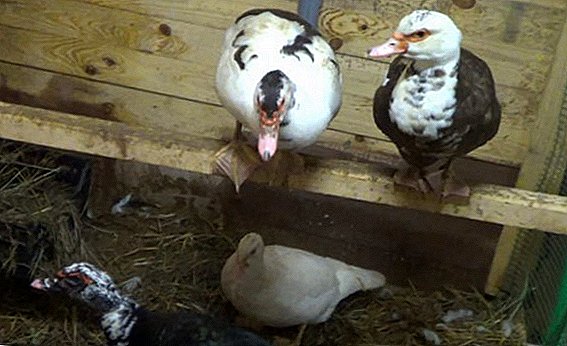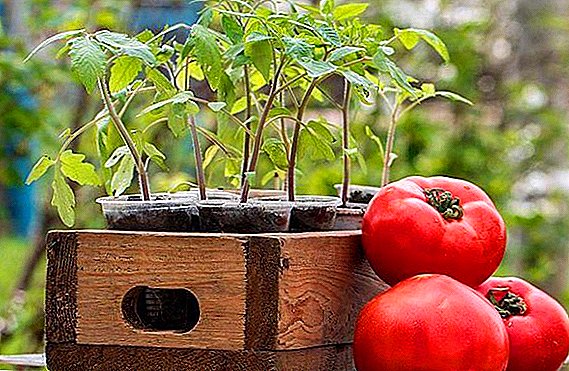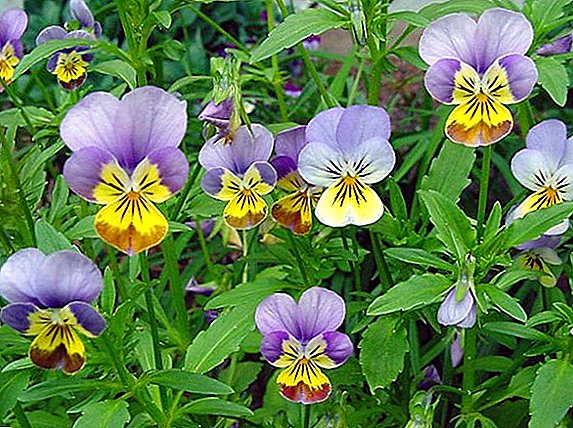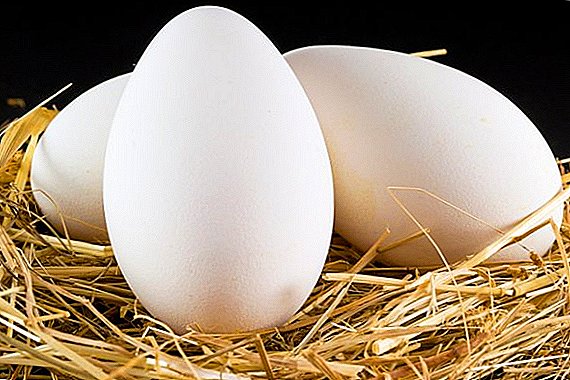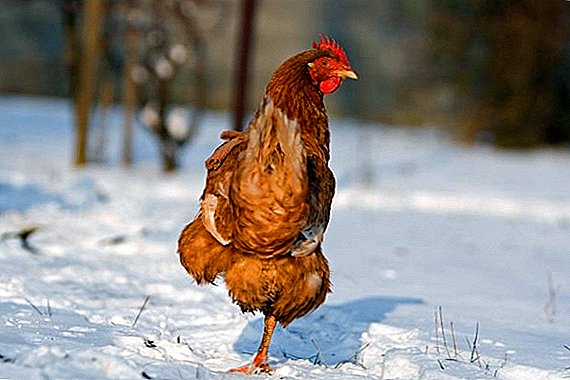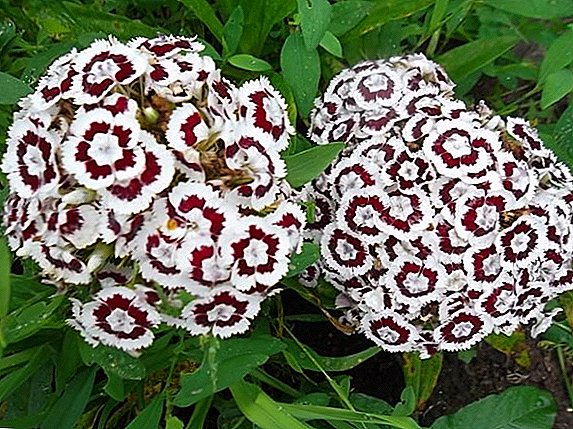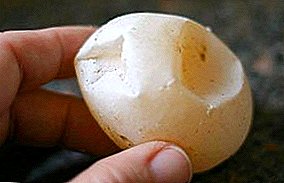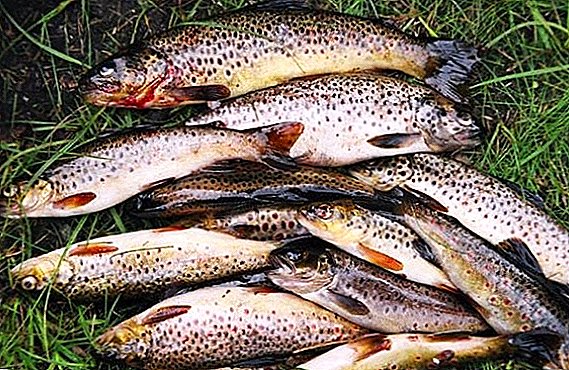 Trout meat is dietary and healthy, and also has a high cost. If you want to pamper yourself with fresh fish more often and at the same time not to devastate the family budget, you should think about its breeding, especially since such an activity can even be turned into a business. How to breed trout at home - try to find out.
Trout meat is dietary and healthy, and also has a high cost. If you want to pamper yourself with fresh fish more often and at the same time not to devastate the family budget, you should think about its breeding, especially since such an activity can even be turned into a business. How to breed trout at home - try to find out.
Choice of species for breeding
Of the more than 20 existing species of this fish, only 2 are suitable for breeding — a brook (pied) and rainbow. They are predators, so they can equally be given as food as dragonflies, beetles, frogs, and small species of fish.
Otherwise, they have a lot of differences that should be taken into account when breeding. 
Brook
Piedchus can live up to 12 years, and its maximum weight reaches 12 kg. Spawning begins after 3 years. Fecundity - 200-1500 eggs, depending on the weight of the female.
The duration of the incubation period varies based on the temperature:
- + 8 ° С - up to 3 months;
- + 2 ° С - up to 7 months.
Incubation of caviar occurs in the fall. This species does not grow as fast as rainbow trout, but they can be well kept together. 
Rainbow
Sexual maturity comes at the age of 2 years. You can see this on a wide and clear iridescent strip on the body of the male. Females produce from 800 to 3000 eggs.
Fish feel good in cold waters, but in warm water their growth is accelerated. Optimally contain at + 14-16 ° C.
Choose subspecies such as the Donaldson trout and the deep-water Canadian Kamloops. They are more prolific than others (by 30%), besides, they grow several times faster. 
The choice of growing places
You can choose several places for breeding fish - the combined methods help to achieve good growth. For eggs there can be one tank, for young and adult fish - cages, and for large individuals - separate reservoirs. Bred in a pond, cages, pools, installations of closed water supply (UZV).
Pond
You can use an existing pond or you can build it yourself. The first option is less desirable - it’s difficult to maintain ideal conditions for fish farming and it’s almost impossible to protect a pond from poachers.
We advise you to read about which aquatic plants are best for your pond and how to choose them.
In the pond, where trout is bred, it is necessary to make a flow: this will provide fresh and cool water. Stagnant water will be saturated with oxygen, and the pond itself will be cleansed of food and waste products of trout.
If you dig a pond yourself, then it will be difficult to maintain a temperature not lower than + 2 ° С without special devices, which is why the growth of the trout will be slowed down. You can check whether this method is profitable, no less than in 5 years - the fish will already give offspring.  Problems may also arise with reproduction - in such conditions, the fish itself does not spawn, therefore it is necessary to help with fertilization. Individuals are taken out of the water, then the eggs are extracted from the females and the semen from the males, which are then mixed. After 7-10 minutes, fertilization can be considered complete. Caviar ripens in incubation apparatus.
Problems may also arise with reproduction - in such conditions, the fish itself does not spawn, therefore it is necessary to help with fertilization. Individuals are taken out of the water, then the eggs are extracted from the females and the semen from the males, which are then mixed. After 7-10 minutes, fertilization can be considered complete. Caviar ripens in incubation apparatus.
The plus of the self-made pond is that it will not need to spend money on trout feed: in the natural pond she will find it herself - these could be beetles, mosquito larvae, dragonflies. You can only run inexpensive small fish for feeding.
The population density is up to 30 pieces per 1 cu. m
We recommend to learn how to make your own pond for ducks and geese.
Cues
This method is considered the most profitable. Cages - a reservoir enclosed by a structure of metal or dense nylon mesh, stretched on stakes. It looks like a big net - a floating net bag in a frame.
Construct such a structure in open flowing waters in a natural environment. They are different in shape and volume, but not more than 20 m in diameter. It is necessary to make such a room for growing trout at a depth of at least 6 m - at least 1 m should be left from the cage to the bottom. It is possible to anchor the structure.  Falls are:
Falls are:
- with warm water - automated cages of no more than 100 cubic meters. m, can be far from the shore, use without current;
- with cold water - installed on the northern lakes, there are sectional, pontoon and stationary, the volume is not more than 100 cubic meters. m;
- with sea water - pontoon or automated ponds, the volume of which will be no more than 60 cu. m
The population density is no more than 100 individuals per 1 cu. m
Important! Sea water is the most favorable for trout breeding: the metabolism accelerates in such conditions and the fish grows faster.
UZV
The most expensive and effective way of breeding fish - installation of a closed water supply. It looks like this: in a small pool with special equipment, trout are created close to the natural conditions for life. The water is constantly filtered and filled with oxygen.
To create a RAS, the following are required:
- pool;
- filters and biofilters for water;
- denitrification system;
- pumps;
- disinfection systems;
- oxygenator;
- heating systems.
This equipment will provide a constant circulation of water and its purification. In each tank you need to constantly add up to 15% of fresh purified water. Usually in such systems fish are fed with compound feeds, and not natural food.  You can highlight the advantages of this method of breeding:
You can highlight the advantages of this method of breeding:
- fully controlled process - from the state of the water to the amount of feed;
- the ability to maintain the required temperature;
- the result is an environmentally friendly product - the conditions of detention do not allow any external pollutants.
The density of settlement - up to 100 pieces per cubic meter. m
Trout rearing technology
Before proceeding to the choice of a fish breeding site, you should have permission to establish a fish farm on a certain water body (if it is an open source). Next, you need to prove that it does not harm the environment.
Arrangement of growing places
You will need the following equipment:
- incubation apparatus;
- car feeders;
- aerators and compressor stations;
- oxygen cones;
- filters;
- devices for measuring pH and chlorine in water;
- water purifiers;
- buckets, nets.
Malkov immediately colonize the breeding site - cages, ponds or ultrasound. When the fish matures for breeding (from 2 years), the best individuals are selected and transplanted separately in cages - up to 30 pieces per 1 cu. m  After the calf matures in females, it is gently squeezed and mixed with the seed. Until hatching of fry, the eggs are kept in special incubators for up to a month. In the first year of the fry born, it is advisable to settle in a separate cage.
After the calf matures in females, it is gently squeezed and mixed with the seed. Until hatching of fry, the eggs are kept in special incubators for up to a month. In the first year of the fry born, it is advisable to settle in a separate cage.
For breeding fish in the pond create clay dams. To prevent them from eroding over time, concrete slabs are constructed around the reservoir. It also helps to avoid unwanted water pollution.
Did you know? In hot weather in natural habitat, trout can be harvested by hand - it falls into a coma.
Regardless of the breeding site, aerators will be needed so that there is always a flow of fresh and cool water. The temperature must be monitored - indicators less than + 2 ° C and more than + 20 ° C for trout can end in death. Therefore, it is important to provide the reservoir with heaters.
Purchase fry
It is better to buy fry at the age of 1 year, then the probability that it will be eaten by a predator is reduced by 90%. When buying, keep in mind that up to 10% of the fry will die in the process of growing, and the rest in a few years will reach a weight of about 500 g.
It is better to buy them on fish farms: there you can see in what conditions they keep and feed. After consulting with experienced breeders, you can learn the subtleties of growing this fish and ask for advice for greater profits.
At least 100 fry are bought immediately; an adult formed individual can be caught no earlier than in 4-5 years.
Fry must be active, with an appetite - you can see this by simply watching them on the fish farm. Keep babies in water from + 10 ° to + 14 ° C. 
Water chemistry
Pay attention to:
- oxygen - the normal rate is 7-11 mg / l: the smaller the individual, the greater the rate; in the aeration column, adjust the level of water saturation with oxygen up to 95%;
- pH, or ion concentration in water - the optimal indicator is from 6.5 to 8, when it falls, the trout stops multiplying, and with an increase to 9 it can die;
- carbon dioxide - no more than 25 mg / l;
- ammonia - 0.1 mg / l;
- rigidity - 8-12: can be enhanced by adding lime;
- nitrates - concentration from 100 mg / l is already toxic to trout;
- chlorine - it should be no more than 0.01 mg / l.
Feeding
The growth rate, color of meat and its taste qualities depend on the fish nutrition. Fatter and more delicious will be the trout meat grown on organic food, not dry. When catacanthin is added to the diet, the fish meat becomes saturated red.
Fry
Begin feeding individuals from the larvae - for them prepare zooplankton with egg yolk and spleen. When they grow up to fry, mash potatoes are prepared for them: they are ground spleen, meat-fish meal and fish oil.  Diet - up to 9 times a day. For a thousand individuals need 90 g of feed. For artificial feeding with feeds, you can choose a special one for this category. Feed can be floating and sinking.
Diet - up to 9 times a day. For a thousand individuals need 90 g of feed. For artificial feeding with feeds, you can choose a special one for this category. Feed can be floating and sinking.
Adult
Dry or live food is suitable for this group. Their combination is possible in the ratio of 40% to 60%. Feed can be milled with meat and giblets of animals, fish production waste, shrimp, mollusks, bugs, insects. Fiber is not absorbed in the body of trout, but it is suitable for loosening feed.
Temperature
Sudden drops can damage the trout, so it’s best to keep the temperature at the same level. In winter, in natural reservoirs it is difficult to heat the water, therefore it is better to temporarily fish the fish in ultrasonic, where the temperature will be from + 14 ° C - it should gradually rise from the indicator that was in the natural reservoir.
Caviar ripens at + 6-12 ° С, fry comfortably at + 10-14 ° С, adults function well at temperatures up to + 16 ° С.
Care
For fast and high-quality growth of fish you need:
- maintain aeration of water, normal temperature;
- clean water on a regular basis (filters);
- weaker and smaller fish are better left out; they will also grow faster when they are separately fed;
- check water indicators with special devices (acidity, pH, salinity, the presence of nitrates, chlorine);
- to relocate the best individuals during spawning for artificial insemination.
Did you know? The trout travels faster than other freshwater fish almost twice - it can reach a speed of 16 km / h.
Trout rearing rates
With proper care, you can observe the following growth rates for rainbow trout:
- fry first year weigh up to 30 g;
- from a year fish gains up to 125 g;
- from 2 years old - about 200 g
 At brook trout:
At brook trout:- one year old weighs up to 25 g;
- individual of two years - 150-170 g;
- in three years - up to 500 g
Disease prevention
The following factors can cause illness:
- dense placement of fish in the reservoir;
- purchase of already sick fry;
- improper conditions of detention.
Important! For any manifestation of the disease, the fish should be placed in quarantine, separately from healthy individuals.
With improper feeding, liver and stomach diseases are possible, therefore, fish should not be fed with stale food, compound feed with cotton cake in the composition, it is also not recommended to exceed the required amount.
Infectious diseases can be expressed in a change in the color of the fish (scales brighten), slowness, refusal to eat. Such individuals are immediately visible among the rest, and they must be removed in order to avoid infection.  For the prevention of disease you need:
For the prevention of disease you need:
- feed with high-quality granulated or live food;
- sort the fish by age and remove small individuals, as they are weaker;
- measure the water temperature at least 3 times a day;
- control the process of cleaning and aeration of water;
- 2-3 times a year to do chemical analysis of water;
- When transporting or purchasing new fry, the fish should be quarantined for some time.
We advise you to read about carp breeding at home.
Is it possible to transfer to salt water
In salt water, trout grows much faster, the taste of its meat also improves. If initially fish breeding was started in fresh water, then the transition to salt water should occur gradually.
Young animals normally function at a rate of 3 to 9 ppm fish, from 2 years old it is already possible to live in water with a salinity index of 12-15. Fresh water is changed to saline no more than 1 liter at a time so that the fish can adapt to the change.
Common mistakes
Inexperienced fish farmers make such mistakes:
- they allow trout breeding to flow by gravity - they do not analyze water, do not measure temperature, do not carry out cleaning;
- buy cheap feed - this can lead to a loss of up to 50% of individuals;
- they save on the volume of water bodies - you need to adhere to the norms of fish population density for each of the possible breeding options;
- savings on equipment;
- purchase of fry on unauthorized farms.
Video: how to grow trout in 3 ways
We found that trout breeding is a time consuming and expensive process. But after 5 years, you can make a profit from farmed animals. In addition, this activity can be cyclical, if you breed trout in an artificial way.


